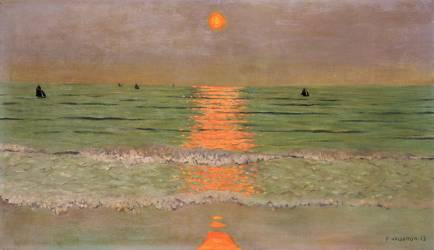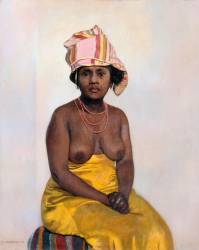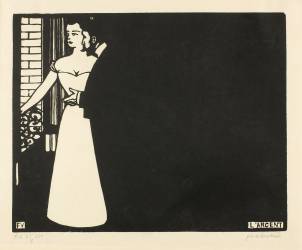Félix Vallotton canvas prints & artprints
The art world has seen many remarkable artists, but few have combined a diversity of talents with artistic originality like Félix Vallotton. This illustrious French painter of Swiss origin forged a name for himself on the international art scene and in modern art at the end of the 19th and beginning of the 20th centuries, thanks to his creative genius and mastery of painting techniques, while making his mark with works that took their cue from different artistic disciplines such as engraving, illustration and sculpture.
Discover the paintings and engravings of this strong and distinctive personality of the art world, with the most beautiful paintings, engravings and illustrations from the inordinate collection of this essential painter of the period between the two centuries, with his oil on canvas "Baigneuse Dormant (Femme Nue Couchée Dormant)", a painting representing his favourite subject: the nude woman depicted as a bather, his painting "Self-Portrait", an oil on cardboard now in the Musée d'Orsay collection, his canvas "Interior with a Woman with a Red Back", one of his interior canvases differing from his Nabi period with "The Red Room", or "The Bath" and "Laziness", famous engravings by the artist present on the posters of the finest illustration editions of the late 1800s.
Offer yourself a reproduction of Félix Vallotton available in the catalogue, with his unique paintings representative of the various artistic currents of the period between the two centuries, and find out more about his biography.
Biography of Félix Vallotton
Félix Vallotton's promising beginnings in Lausanne and Paris
Born in Lausanne in 1865, Félix Vallotton was quickly introduced to art through drawing and painting, supported by his parents, middle-class people who did not hesitate to support their children in their choice of an artistic career, his brother himself later becoming an art gallery owner. Determined to pursue a career as an artist, Félix Vallotton left in 1882 to study at the Académie Julian in Paris, a city that would remain at the heart of his artistic life. Vallotton's early years in Paris were rich in encounters that would prove invaluable to his life and career, as he rubbed shoulders with the post-impressionists and innovative painters of the day, such as Édouard Vuillard, Pierre Bonnard and Maurice Denis, who would later form the Nabis group, and Thadée Natanson, founder of the review "La Revue Blanche". In 1883, Vallotton was admitted to the École des Beaux Arts in Paris, and met Félix Jasinski, who introduced him to wood engraving, and whose portrait he would paint on several occasions.
Félix Vallotton's rapid rise in the Parisian art world
A diligent worker, Félix Vallotton honed his style and skills in oil painting on canvas. His canvases quickly won over the Parisian art world, opening the doors to official Salons and prestigious exhibitions for him from 1885 onwards. He exhibited several paintings there, including the portrait of Monsieur Ursenbach, presented at the Salon des artistes français in 1885, and his self-portrait, an oil on canvas presented at the Salon des Champs-Élysées the same year.
Félix Vallotton's artistic development at the turn of the century
As his fame grew, Vallotton continued to evolve as an artist, experimenting with different styles and techniques. With the arrival of Japanese prints at the end of the 19th century, opening up a veritable gateway to a different way of looking at art in Europe, the Helvetian artist also allowed himself to be seduced by the woodcut technique.
Specialising in this field from 1890, he stood out for his use of large black and white solids, without the use of greyscale, for his innovative themes for the time, with the depiction of contemporary life, but also for the dynamic poses of the characters illustrated, differing from his frozen portraits.
This singularity then led him to become close to the newly-formed Nabis group, led by his friends Pierre Bonnard and Édouard Vuillard, who opened the doors to the Revue Blanche, a magazine with an anarchist code whose pages Félix Vallotton illustrated with a whole collection of engravings that found real exposure here among the French and European artistic sphere, and which led him to be published in "Les maîtres de l'affiche", a directory of the most beautiful posters produced during the year.
Alongside designing over a hundred engravings, Félix Vallotton continued to use the technique of oil on canvas, but also oil on cardboard, painting one picture after another. However, his style changed completely. Drawing inspiration from his Japanese period with his woodcuts, he abandoned perspective and imposed large flat areas of colour, following the precepts of the Nabis, as in his painting "Bathing on a Summer Evening", taking up his favourite theme of the bather, which was decried by detractors of the Nabi movement when it was shown at the 1893 Salon des Indépendants.
Félix Vallotton's multiple and varied artistic repertoire
In 1899, after 10 years within the Nabi family, the Swiss painter wishing to perpetuate his work, married Gabrielle Bernheim, the daughter of an art dealer, and a member of a key family in the Paris art scene. With his wife, the Swiss painter had to abandon the controversial aspects of his art, and returned almost entirely to painting and the technique of oil on canvas. From then on, and throughout his career, Félix Vallotton showed a marked taste for exploring new artistic fields and distinct thematic horizons, moving with ease from portraiture to still life, from landscapes to intimate genre scenes. Women, particularly the nude, remained at the centre of his inspiration throughout his career, however, and were represented in a variety of forms, from nude bathers to society portraits. This enduring fascination with feminine beauty testifies to his deep and abiding attention to the models he chooses.
Félix Vallotton: A political commitment and social criticism
Félix Vallotton's work is marked by a deep political commitment and incisive social criticism. Through his paintings and engravings, Vallotton mocked the realities of the society of his time. A convinced anarchist during his youth with the Nabis, he highlighted social inequalities, injustices and abuses of power, as in his engravings "La Charge", "La Manifestation" and "L'Assassinat", but also by highlighting black women on an equal footing with white women, as in his "Portrait d'une femme africaine", thus expressing his desire for change and justice. Spurred on by the editions featuring the engravings and paintings of the Nabis, his work repeatedly featured paintings denouncing the failings of the bourgeoisie, political corruption and the precarious living conditions of the working classes. Although this anarchist tendency diminished after his marriage, Vallotton positioned himself as a critical observer of society, inviting viewers to reflect on the political and social issues of his time.
A prolific late career for Félix Vallotton
Following his marriage, Vallotton enjoyed a reputation within the Parisian and European artistic microsphere. This led to his first solo exhibition in Zurich, in his native country, in 1909. The Swiss artist, who became French in 1900 but remained attached to his original nationality, went on to hold a string of exhibitions, notably in Paris at the Galerie Druet, but also abroad, in the United States and Switzerland, mainly in Lausanne, where his brother had become the director of a branch of the Galerie Bernheim-Jeune. Vallotton painted a plethora of canvases, mainly portraits, landscapes, nudes and bathers, some of which were strongly inspired by the First World War, including "La Guerre (étude)" (1915) and "Paysage de ruines et d'incendies" (1915 - Kunstmuseum de Bern). Devoting himself to travelling, from which he would draw a whole series of landscapes, Félix Vallotton died in 1925, following an operation to treat cancer, shortly after completing "La Femme au chevalet" (1925), an oil on canvas now considered to be a self-portrait of a woman, further highlighting his fascination with female beauty.
The precious and enduring legacy of Félix Vallotton
Despite his discreet personality, Félix Vallotton left a lasting mark on art history thanks to his countless works and multiple talents. His artistic legacy includes many iconic paintings such as "Le Bain au soir d'été" (1892, Kunsthaus Zurich), "La chambre rouge" (1898 - Musée cantonal des beaux-arts de Lausanne), "Le beau soir" (1892 - Centre Pompidou, Paris), "Femme nue tenant un livre" (1924, Kunsthaus de Zurich), "Étude de fesses" (1884), the oil on board "Femmes nues jouant aux dames" (1897 - Musées d'art et d'histoire de Genève) or "Autoportrait" (1897 - Musée d'Orsay de Paris).
His work is now preserved and exhibited in the world's leading museums, including the Musée d'Orsay in Paris, the Metropolitan Museum of Art in New York, the Musée d'art moderne André Malraux in Le Havre, and in his native country at the Kunsthaus in Zurich, the Palais des Beaux-Arts in Lausanne and the Musées d'Art et d'Histoire in Geneva.
Beyond his career as a painter and engraver, Vallotton is also a renowned illustrator, sculptor and writer. His illustrations were published in several prestigious editions of the time, while his sculptures also managed to earn a prominent place in art collections around the world. He also wrote numerous reviews, plays and at least three novels during his career, making him, along with his more than one thousand seven hundred paintings, two hundred and fifty engravings, and hundreds of illustrations, one of the most prolific artists of his time.
His work, whether in painting, engraving, illustration or sculpture, continues to arouse admiration among art specialists and the general public alike, as demonstrated by the major retrospective devoted to his work at the Grand Palais in 2013 and 2014. Today, his creations remain keystones for understanding the aesthetic and intellectual transformations in the history of modern art at the end of the nineteenth century.
Learn more about the life and the works of Félix Vallotton.
Artworks from Felix Vallotton into canvas prints & artprints

See all
artworks from
Félix VallottonDiscover
- 30% !
Make good deals by browsing our Reserve : editions of our catalog which await their purchaser at a low price.










































